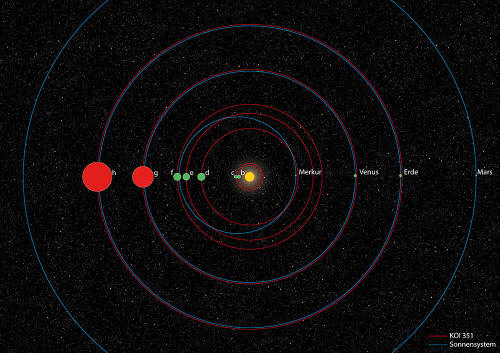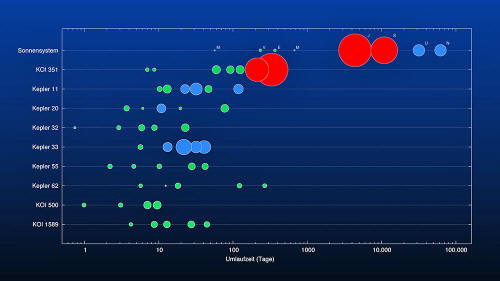|
28 October 2013
Comparison of KOI-351
with the Solar System
with all known
planetary systems with five or more transiting planets
Seven planets circle the star KOI-351 - more than in other known planetary systems.
They are arranged in a similar fashion
to the eight planets in the Solar System, with small rocky planets
close to the parent star and gas giant planets at greater distances.
Although the planetary system around KOI-351 is packed together more
tightly, it provides an interesting comparison to our cosmic home.
Three of the seven planets in orbit
around the star KOI-351 were discovered
in recent years, and have periods of 331, 211 and 60 days, similar
to those of Earth, Venus and Mercury.
The outermost planet orbits the star at
a distance of about 150 million kilometers, or roughly one
Astronomical Unit (AU), so the entire planetary system is
compressed into a space corresponding to the distance between Earth
and the Sun.
Heike Rauer, head of the Extrasolar Planets and Atmospheres working group at the DLR Institute of Planetary Research and professor at the Centre for Astronomy and Astrophysics at the University of Berlin, adds:
Tilman Spohn, Head of the DLR Institute of Planetary Research states that:
The DLR astrophysicist was able to filter out the light curves that reveal the 'transit' of a planet across its parent star from the Kepler measurements. A transit is inferred from the small, periodic dimming of the star's light as the planet crosses the star's disc.
This technological development is likely
to be crucial in the search for similar multiple systems using large
data sets from future space telescopes. The discovery was confirmed
shortly afterwards by a US group led by Joseph R. Schmitt of
Yale University, by visual inspection of the light curves recorded
by Kepler.
At present, KOI-351 is the star with the most extrasolar planets, or exoplanets for short.
The star is 2500 light years away from
Earth.
The resonances in the planetary system of KOI-351, however, greatly complicated the search for the planets.
Due to the strong interaction between the planets, the signals sought by Juan Cabrera in the Kepler data were not strictly periodic, but showed strong variations in the orbital periods.
Rudolf Dvorak of the University of Vienna highlights the planet KOI-351g as being particularly interesting:
After the two successful space telescopes CoRoT and Kepler were decommissioned this year, planet hunters are now hopeful with regard to the pending decision on the PLATO mission.
PLATO (Planetary Transits and Oscillations of Stars) will build on the experience of CoRoT and Kepler in the search for planetary systems around nearby bright stars, and thus allow for extensive follow-up observations. This could allow the determination of the radius (as in the system KOI-351) and the mass of the planets, as well as a first look at the composition of the planet.
Furthermore, it would even be possible to examine the atmosphere of the planets in such systems, which may give rise to indications of the activity of living organisms. This would be a major breakthrough in search for a 'second Earth'.
The European Space Agency will make a
decision on the PLATO mission in early 2014.
Only 170 stars are known to be orbited by more than one planet. Large planetary systems are the exception - not because they do not exist, but because they are particularly difficult to detect and characterize.
At present, only a handful of systems with at least five planets have been confirmed.
"We Cannot Stress Just
How Important This
Discovery Is"
A team of European astrophysicists has discovered the most extensive planetary system to date that orbit star KOI-351 - with seven planets, more than in other known planetary systems arranged in a similar fashion to the eight planets in the Solar System, with small rocky planets close to the parent star and gas giant planets at greater distances.
Although the planetary system around KOI-351 is packed together more tightly,
KOI is the abbreviation for 'Kepler Object of Interest', which means the star was observed by NASA's Kepler space telescope, between 2008 and 2013, and classified as a candidate for the existence of exoplanets.
At present, KOI-351 is the star with the most extrasolar planets, or exoplanets for short. The star is 2500 light years away from Earth.
Astrophysicists around the world have been searching for a star system similar to our own for a long time.
Now, the team led by Cabrera has taken a major step in this direction. Three of the seven planets in orbit around the star KOI-351 were discovered in recent years, and have periods of 331, 211 and 60 days, similar to those of Earth, Venus and Mercury.
The planets discovered by Cabrera and his team are even closer to the star and have orbital periods of 7, 9, 92 and 125 days.
The outermost planet orbits the star at a distance of about 150 million kilometers, or roughly one Astronomical Unit (AU), so the entire planetary system is compressed into a space corresponding to the distance between Earth and the Sun.
The development of a special computer algorithm enabled Cabrera and his team to detect the four new planets around KOI-351 by filtering out the light curves that reveal the 'transit' of a planet across its parent star from the Kepler measurements.
The discovery was confirmed shortly afterwards by a US group led by Joseph R. Schmitt of Yale University, by visual inspection of the light curves recorded by Kepler.
The resonances in the planetary system of KOI-351, however, greatly complicated the search for the planets.
Due to the strong interaction between the planets, the signals sought in the Kepler data were not strictly periodic, but showed strong variations in the orbital periods.
After the two successful space telescopes CoRoT and Kepler were decommissioned this year, planet hunters are now hopeful with regard to the pending decision on the PLATO mission.
PLATO (Planetary Transits and Oscillations of Stars) will build on the experience of CoRoT and Kepler in the search for planetary systems around nearby bright stars, and thus allow for extensive follow-up observations. This could allow the determination of the radius (as in the system KOI-351) and the mass of the planets, as well as a first look at the composition of the planet.
Furthermore, it would even be possible to examine the atmosphere of the planets in such systems, which may give rise to indications of the activity of living organisms. This would be a major breakthrough in search for a 'second Earth'.
The European Space Agency will make a decision on the PLATO mission in early 2014.
Until now, 771 stars with planets have been identified. However, most of the exoplanets discovered so far are 'solitary'. Only 170 stars are known to be orbited by more than one planet. Large planetary systems are the exception - not because they do not exist, but because they are particularly difficult to detect and characterize.
At present, only a handful of systems with at least five planets have been confirmed, including planets KOI-351b and 351c were confirmed. They are only 31 percent and 19 percent larger than the Earth. To detect such small planets, a special algorithm was developed by Cabrera.
Besides the size of these planets, what is remarkable is the 5:4 orbital resonance. In the time it takes planet b to complete five orbits, planet c has completes exactly four orbits.
Similar resonances are found among the inner moons of Jupiter.
Planet KOI- 351d was already known. It has an orbital period of 60 days. Its diameter is 2.9 times that of Earth's. It is therefore likely a 'super-Earth' or a 'mini-Neptune'. Since the mass is not known, it is not yet possible to classify this planet.
The planet KOI-351e is also a new discovery and is roughly the same size as KOI- 351d (2.9 times the diameter of Earth). We know that neighboring planets in planetary systems have similar sizes, as we see in the Solar System (Neptune and Uranus, or Venus and Earth). This has now been observed for the first time in exoplanets, and underlines the similarity of this system to our own.
The large gas giants KOI-351g and 351h (about 8 and 11 times the diameter of Earth) are outer planets and have long orbital periods (211 and 331 days).
This is very reminiscent of the Solar System, where there also four rocky planets (Mercury, Venus, Earth, Mars) and two gas giants (Jupiter and Saturn ) with diameters 10 and 8 times that of Earth.
...with
Our Sixth Exoplanet Paper
from
PlanetHunters Website
We have identified a seventh candidate, marking KOI-351 as the first Kepler seven planet system.
While we cannot yet confirm the candidates in KOI-351, gravitational interactions between the planet candidates overwhelmingly point to their planetary nature. It is also known that false positives in multiple candidate systems are extremely rare.
All of this together makes KOI-351 the strongest case for the first seven planet system known (apart from our own Solar System, of course!) The new planet is the fifth furthest from its parent star, orbiting with a period of nearly 125 days.
With a radius of 2.8 times that of the
Earth (+/- 1.1) it fits snugly into a family that now includes two
roughly Earth sized worlds, three 'super-Earths' and two larger
bodies.
Additionally, five of these new candidates met the requirements to have been detected by the Kepler team's automated Transit Planet Search algorithm, but were undetected, including KOI-351.07, the newly discovered seventh candidate.
Read also, "Whose planet is it anyway?".
|


